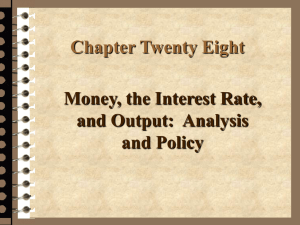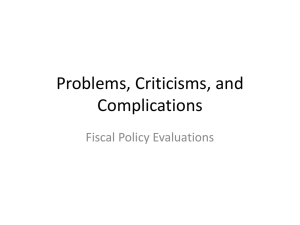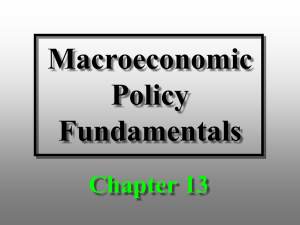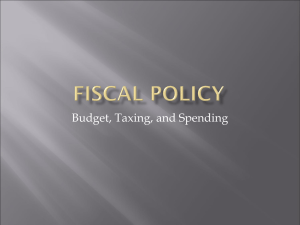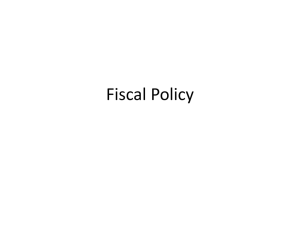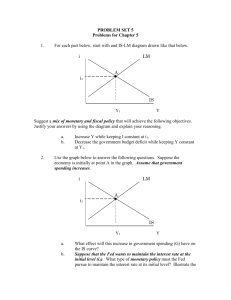Brief answers to problems and questions for review
advertisement
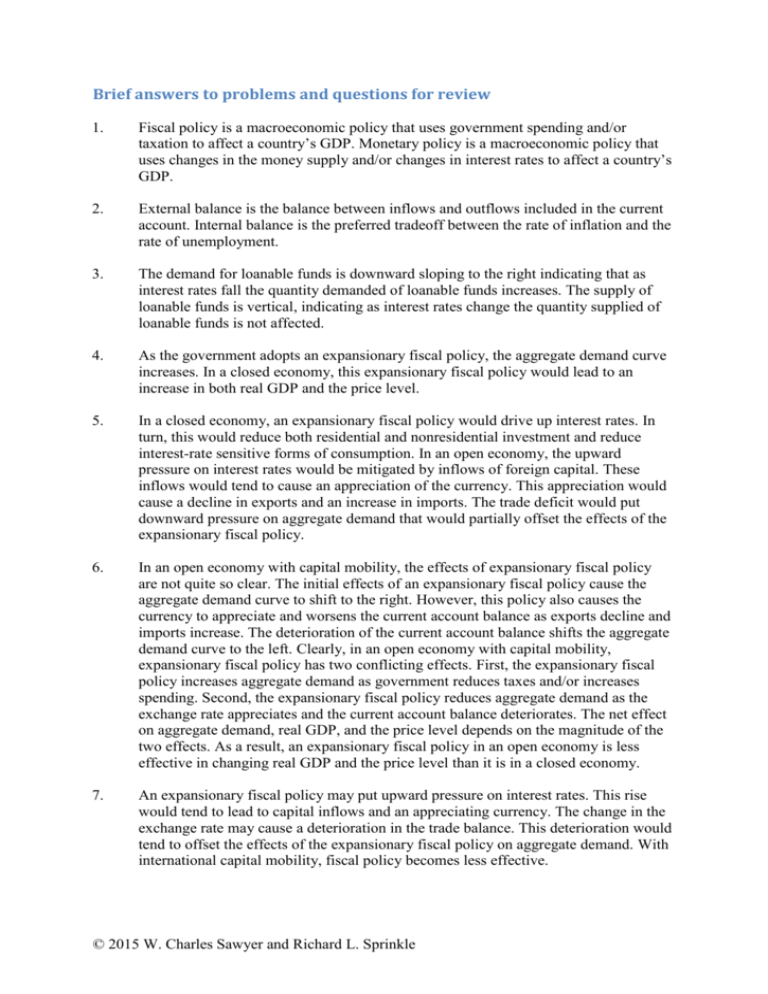
Brief answers to problems and questions for review 1. Fiscal policy is a macroeconomic policy that uses government spending and/or taxation to affect a country’s GDP. Monetary policy is a macroeconomic policy that uses changes in the money supply and/or changes in interest rates to affect a country’s GDP. 2. External balance is the balance between inflows and outflows included in the current account. Internal balance is the preferred tradeoff between the rate of inflation and the rate of unemployment. 3. The demand for loanable funds is downward sloping to the right indicating that as interest rates fall the quantity demanded of loanable funds increases. The supply of loanable funds is vertical, indicating as interest rates change the quantity supplied of loanable funds is not affected. 4. As the government adopts an expansionary fiscal policy, the aggregate demand curve increases. In a closed economy, this expansionary fiscal policy would lead to an increase in both real GDP and the price level. 5. In a closed economy, an expansionary fiscal policy would drive up interest rates. In turn, this would reduce both residential and nonresidential investment and reduce interest-rate sensitive forms of consumption. In an open economy, the upward pressure on interest rates would be mitigated by inflows of foreign capital. These inflows would tend to cause an appreciation of the currency. This appreciation would cause a decline in exports and an increase in imports. The trade deficit would put downward pressure on aggregate demand that would partially offset the effects of the expansionary fiscal policy. 6. In an open economy with capital mobility, the effects of expansionary fiscal policy are not quite so clear. The initial effects of an expansionary fiscal policy cause the aggregate demand curve to shift to the right. However, this policy also causes the currency to appreciate and worsens the current account balance as exports decline and imports increase. The deterioration of the current account balance shifts the aggregate demand curve to the left. Clearly, in an open economy with capital mobility, expansionary fiscal policy has two conflicting effects. First, the expansionary fiscal policy increases aggregate demand as government reduces taxes and/or increases spending. Second, the expansionary fiscal policy reduces aggregate demand as the exchange rate appreciates and the current account balance deteriorates. The net effect on aggregate demand, real GDP, and the price level depends on the magnitude of the two effects. As a result, an expansionary fiscal policy in an open economy is less effective in changing real GDP and the price level than it is in a closed economy. 7. An expansionary fiscal policy may put upward pressure on interest rates. This rise would tend to lead to capital inflows and an appreciating currency. The change in the exchange rate may cause a deterioration in the trade balance. This deterioration would tend to offset the effects of the expansionary fiscal policy on aggregate demand. With international capital mobility, fiscal policy becomes less effective. © 2015 W. Charles Sawyer and Richard L. Sprinkle 8. If the government adopts a contractionary fiscal policy by increasing taxes and/or decreasing spending, then this reduces the economy’s demand for loanable funds. As a result, a contractionary fiscal policy initially lowers the interest rate. In an open economy with capital mobility, lower interest rates affect capital flows into the country. With lower interest rates, both domestic and foreign investors would tend to invest less capital in the domestic economy, and domestic investors would tend to invest more capital abroad. The net result is an outflow of capital from the domestic economy. This capital outflow decreases the supply of loanable funds available domestically and interest rates rise. As a result in an open economy with freely flowing capital, a contractionary fiscal policy puts less downward pressure on interest rates than would be the case in a closed economy. As investors move capital to foreign countries, the domestic currency depreciates and the country’s current account moves to a surplus. These effects impact the economy’s real GDP and the price level. As the government adopts a contractionary fiscal policy, aggregate demand decreases. In a closed economy, this contractionary fiscal policy would lead to a decrease in both real GDP and the price level. In an open economy with capital mobility, the effects of a contractionary fiscal policy are not quite so clear. A contractionary fiscal policy causes the aggregate demand curve to shift to the left. However, this policy also causes the currency to depreciate, and the current account balance improves as exports expand and imports decline. The improvement in the current account shifts the aggregate demand curve to the right. In an open economy with capital mobility, a contractionary fiscal policy has two conflicting effects. First, the contractionary fiscal policy decreases aggregate demand as government increases taxes and/or reduces spending. Second, the contractionary fiscal policy increases aggregate demand as the currency depreciates and the current account balance improves. The net effect on aggregate demand and on real GDP and the price level depends on the magnitude of the two effects. As a result, contractionary fiscal policy in an open economy is less effective in changing real GDP than it is in a closed economy. 9. With no capital mobility, a contractionary fiscal policy would lower aggregate demand. In turn, this would put downward pressure on the price level (P) and real GDP (Y). In a world of capital mobility, the effects are different. The contractionary fiscal policy would put downward pressure on interest rates and lead to capital outflows. This could lead to currency depreciation and an improvement in the trade balance. This improvement would have a tendency to shift the aggregate demand curve to the right and lessen the effects of the contractionary fiscal policy on P and Y. 10. An expansionary monetary policy in an open economy occurs when the central bank increases the money supply. The increase in the money supply causes interest rate to fall. The decrease in the interest rate has a predictable effect on international capital flows. Foreign investors will be less likely to place their capital in the domestic capital markets and domestic investors would be more likely to place their capital in foreign capital markets. The decrease in interest rates causes a capital outflow leading to a depreciation of the currency. This depreciation and the capital account deficit translate into a current account surplus as exports expand and imports contract. These movements in the exchange rate, the capital account, and the current account tend to reinforce the initial effects of monetary policy on the economy. In an open economy with capital mobility, the fall in interest rates induces a depreciation of the currency as capital flows out of the country. Along with the capital outflow, the depreciation of the exchange rate induces an improvement in the current account as exports expand © 2015 W. Charles Sawyer and Richard L. Sprinkle and imports contract. The current account surplus shifts the aggregate demand curve even further to the right. This additional increase in aggregate demand in turn leads to large increases in real GDP and the price level. 11. An expansionary monetary policy would put downward pressure on interest rates that could lead to capital outflows. These outflows could lead to a depreciating currency and an improvement in the trade balance. This effect would tend to shift the aggregate demand curve even further to the right than would be the case if there was no capital mobility. 12. The reduction of inflation would imply a contractionary monetary policy. With capital mobility, the reduction in aggregate demand would be even larger than would be the case with no capital mobility. This is because a contractionary monetary policy that raise interest rates would tend to cause the currency to appreciate and the trade balance to worsen. This would tend to move aggregate demand to the left even more than would be the case if there was no capital mobility. 13. Consistent policy mixes have clear effects on the price level (P) and real GDP (Y). However, the effects of a consistent policy mix on the exchange rate are unclear. For example, an expansionary fiscal policy would tend to lead to appreciation of the currency and an expansionary monetary policy may lead to depreciation. The effects on the exchange rate are uncertain. If the exchange rate effect is not known, then the effects on the current account are likewise unknown. 14. In most countries, elected officials are in charge of fiscal policy. They set taxes and decide on government spending. Further, in many countries the government has practically stopped using fiscal policy as a tool to stabilize the economy in the short run. Further, most countries have delegated monetary policy to an independent central bank. The central bank is left with the task of managing the economy in the short run. Under these circumstances, it is quite possible to have a mix of expansionary fiscal policy and a contractionary monetary policy. 15. a. A combination of both expansionary fiscal policy and expansionary monetary policy would tend to increase real GDP. In addition, there would be upward pressure on the price level. Conducting both expansionary monetary and fiscal policies has an unclear effect on the exchange rate. An expansionary fiscal policy would tend to cause the currency to appreciate, while an expansionary monetary policy causes it to depreciate. The effect of these two policies in combination is unclear. The currency may appreciate or depreciate depending on the magnitude of the change in fiscal policy and monetary policy on the economy’s domestic interest rates. Since the exchange rate effect is unclear, the effect of expansionary monetary and fiscal policy on the country’s current account is also unclear. If the combination of expansionary monetary and fiscal policy causes lower interest rates, then the currency would depreciate and the country’s current account would improve. If the policy mix causes domestic interest rates to rise, the currency would tend to appreciate and the current account balance would deteriorate. From a policymaker’s perspective, battling a recession and letting the country’s external balance adjust to the change in interest rates is relatively safe. In this case, the domestic economy © 2015 W. Charles Sawyer and Richard L. Sprinkle would improve as real GDP increases and the current account is unlikely to change in either direction by a large amount. b. An expansionary fiscal policy coupled with a contractionary monetary policy can have ambiguous effects on the domestic economy in the short run. In this case, real GDP and the price level may rise or fall depending on the size of the two policies. However, an expansionary fiscal policy coupled with a contractionary monetary policy causes the currency to appreciate. Likewise, the current account balance will deteriorate. In this case, both fiscal and monetary policies reinforce each other and the effect on a country’s current account can be quite significant. c. A contractionary fiscal policy coupled with an expansionary monetary policy can have ambiguous effects on the domestic economy in the short run. In this case, real GDP and the price level may rise or fall depending on the size of the two policies. However, a contractionary fiscal policy coupled with an expansionary monetary policy causes the currency to depreciate. Likewise, the current account balance improves. In this case, both fiscal and monetary policies reinforce each other and the effect on a country’s current account can be quite significant. d. A combination of both a contractionary fiscal policy and a contractionary monetary policy would tend to decrease real GDP. In addition, there would be downward pressure on the price level. Conducting both contractionary monetary and fiscal policies has an unclear effect on the exchange rate. A contractionary fiscal policy would tend to cause the currency to depreciate, while a contractionary monetary policy causes it to appreciate. The effect of these two policies in combination is unclear. The currency may depreciate or appreciate depending on the magnitude of the change in fiscal policy and monetary policy on the economy’s interest rates. Since the exchange rate effect is unclear, the effect of contractionary monetary and fiscal policy on the country’s current account is also unclear. If the combination of contractionary monetary and fiscal policy causes lower interest rates, then the currency would depreciate and the country’s current account would improve. If the policy mix causes domestic interest rates to rise, the currency would tend to appreciate and the current account balance would deteriorate. From a policymaker’s perspective, battling inflation and letting the country’s current account adjust to the change in interest rates is relatively safe. In this case, inflation within the domestic economy would improve as real GDP decreases and the current account is unlikely to change in either direction by a large amount. 16. A combination of both expansionary fiscal policy and expansionary monetary policy would tend to increase real GDP. In addition, there would be upward pressure on the price level. Conducting both expansionary monetary and fiscal policies has an unclear effect on the exchange rate. An expansionary fiscal policy would tend to cause the currency to appreciate, while an expansionary monetary policy causes it to depreciate. The effect of these two policies in combination is unclear. The currency may appreciate or depreciate depending on the magnitude of the change in fiscal policy and monetary policy on interest rates. Since the exchange rate effect is unclear, the effect of expansionary monetary and fiscal policy on the country’s current account is also unclear. If the combination of expansionary monetary and fiscal policy causes lower interest rates, then the currency would depreciate and the country’s current account would improve. If the policy mix causes interest rates to rise, the currency © 2015 W. Charles Sawyer and Richard L. Sprinkle would tend to appreciate and the current account balance would deteriorate. From a policymaker’s perspective, battling a recession and letting the country’s current account adjust to the change in interest rates is relatively safe. In this case, the domestic economy would improve as real GDP increases and the current account is unlikely to change in either direction by a large amount. 17. The higher interest rates that go with a contractionary monetary policy tend to lead to an appreciating currency and a current account deficit. An expansionary fiscal policy also tends to lead to higher interest rates, an appreciating currency, and a current account deficit. The mix of the two can lead to an overvalued currency and a large current account deficit. 18. With international capital mobility, a government budget deficit tends to lead to a current account deficit. An expansionary fiscal policy tends to drive up interest rates and leads to capital inflows that cause the currency to appreciate. This appreciation can cause a current account deficit. The logic is that a government budget deficit may lead to a current account deficit, the twin deficits. 19. A policy mix of a contractionary monetary policy and an expansionary fiscal policy could be very damaging to the firm. This policy mix would cause an appreciation of the currency which would make imported cars cheaper and thus harder to compete with. The best policy mix in this regard would be an expansionary monetary policy coupled with a contractionary fiscal policy. Both policies would lead to lower interest rates and a depreciating currency. This would make it somewhat easier for the domestic firm to compete with imports. 20. The two relevant policy mixes are an expansionary fiscal policy coupled with either a contractionary or expansionary monetary policy. In the former case, the effects on the exchange rate and the current account are clear. This is because the effect of this policy mix is lower interest rates. The currency would tend to depreciate and the current account would improve. In the latter case, both policies would have an uncertain effect on interest rates. As a result the effects on the exchange rate and the current account could not be predicted. 21. In the long run, as a country’s currency depreciates (appreciates), its exports expand (contract) and imports contract (expand). However, in the short run as a country’s exchange rate changes, the response of its exports and imports and its current account balance could very easily be in the opposite direction. The problem with the adjustment of a country’s current account to changes in the exchange rate is caused, in part, by the manner in which international trade is conducted. In many cases, international trade in goods and services has been conducted between the parties on a contract basis. For example, the importer may have contracted to purchase a certain amount of goods at a set price as specified in the contract. If the currency depreciates, then the cost of the goods in domestic currency rises with the depreciation. In this case, the exchange rate change causes the value of imports to rise initially after the depreciation. In addition, the value of exports in domestic currency does not change as the exporters are being paid the prearranged price for their goods in domestic currency. The net effect is that the current account balance may initially worsen after a depreciation of a country’s currency and only after a time lag will the current © 2015 W. Charles Sawyer and Richard L. Sprinkle account begin to improve. This effect on a country’s current account balance has been called the J-curve. © 2015 W. Charles Sawyer and Richard L. Sprinkle


